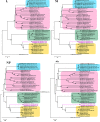Malsoor virus, a novel bat phlebovirus, is closely related to severe fever with thrombocytopenia syndrome virus and heartland virus
- PMID: 24390329
- PMCID: PMC3957954
- DOI: 10.1128/JVI.02617-13
Malsoor virus, a novel bat phlebovirus, is closely related to severe fever with thrombocytopenia syndrome virus and heartland virus
Abstract
During a survey in the year 2010, a novel phlebovirus was isolated from the Rousettus leschenaultii species of bats in western India. The virus was identified by electron microscopy from infected Vero E6 cells. Phylogenic analysis of the complete genome showed its close relation to severe fever with thrombocytopenia syndrome (SFTS) and Heartland viruses, which makes it imperative to further study its natural ecology and potential as a novel emerging zoonotic virus.
Figures



References
-
- Pavri KM, Singh KR, Hollinger FB. 1971. Isolation of a new parainfluenza virus from a frugivorous bat, Rousettus leschenaulti, collected at Poona, India. Am. J. Trop. Med. Hyg. 20:125–130 - PubMed
-
- Newman SH, Field H, Epstein J, de Jong C. (ed). 2011. Investigating the role of bats in emerging zoonoses: balancing ecology, conservation and public health interest. FAO animal production and health manual no. 12. Food and Agriculture Organization of the United Nations, Rome, Italy: http://www.fao.org/docrep/014/i2407e/i2407e00.pdf
MeSH terms
Associated data
- Actions
- Actions
- Actions
- Actions
LinkOut - more resources
Full Text Sources
Other Literature Sources
Molecular Biology Databases

